Today, sea levels rise at a rate double that recorded in the 20th century. That’s a lot, but not nearly as much as climate scientists expected. Researchers at NASA claim they now know why: thirsty continents absorb a great deal of the extra water coming from melting glaciers. They warn, however, that the system will become saturated at one point and the water will be returned to the oceans, as part of the global water cycle.

Continental sponge
To reach this conclusion, a team at NASA’s Jet Propulsion Laboratory (JPL) used one of the most ingenious technique I’ve ever seen. Since the launch in 2002, a pair of satellites known as the Gravity Recovery and Climate Experiment (GRACE) has been orbiting the planet in a cat-and-mouse game. When one of the satellites is directly above a massive object (a mountain) it will become attracted and slightly tug towards it, causing the distance between it and the other satellite to grow. By measuring the distance between the pair of GRACE satellites, researchers can pinpoint how gravity has changed across various points around the globe. But what does gravity has to do with sea level rise?
The only thing that’s massive and mobile enough to affect gravity is water. Every year, Earth’s continents go through 6 trillion tons of snow, soil moisture, groundwater and surface water.This water is absorbed and then released back in the system. It was always assumed that this came at a net loss of water from the land to the ocean due to human activities.
“We always assumed that people’s increased reliance on groundwater for irrigation and consumption was resulting in a net transfer of water from the land to the ocean,” said lead author J.T. Reager of NASA’s Jet Propulsion Laboratory.
“What we didn’t realize until now is that over the past decade, changes in the global water cycle more than offset the losses that occurred from groundwater pumping, causing the land to act like a sponge—at least temporarily.”
Between April 2002 and November 2014, the researchers found that the sea level rose at an average rate of 2.9 millimeters per year, which is pretty huge. They and other researchers, however, expected the rate to be much higher considering the estimated mass of ice melted from the glaciers. Where did this water go? This is where GRACE comes in: verifying the hypothesis that says a lot of this water has been stored in land, on the continents.
“In Southern California we can see the pull of gravity decreasing because of the drought,” said Alex Gardner, a JPL glaciologist who worked on the study. “When there’s a big flood event, we can see the pull of gravity increasing.”
During the same time frame (2002-2014), researchers found continents soaked up an extra 3.2 trillion tons of water, slowing the rate of sea level rise by about 0.71 millimeters per year.That’s a temporary slow down of 20%, the researchers report in the journal Science. Gardner says the land can only store so much water before the continents begin to lose water mass again. We can’t build huge planetary size sponges to trap all this extra water. The only solution, the NASA researchers says, is to reduce carbon emissions and cut down the losses as much as possible.
“We can’t compete with the Earth’s system. It’s just so huge. Some years are wet, some years are dry. You wait long enough and the climate wins,” added Gardner. “Climate always wins.”






